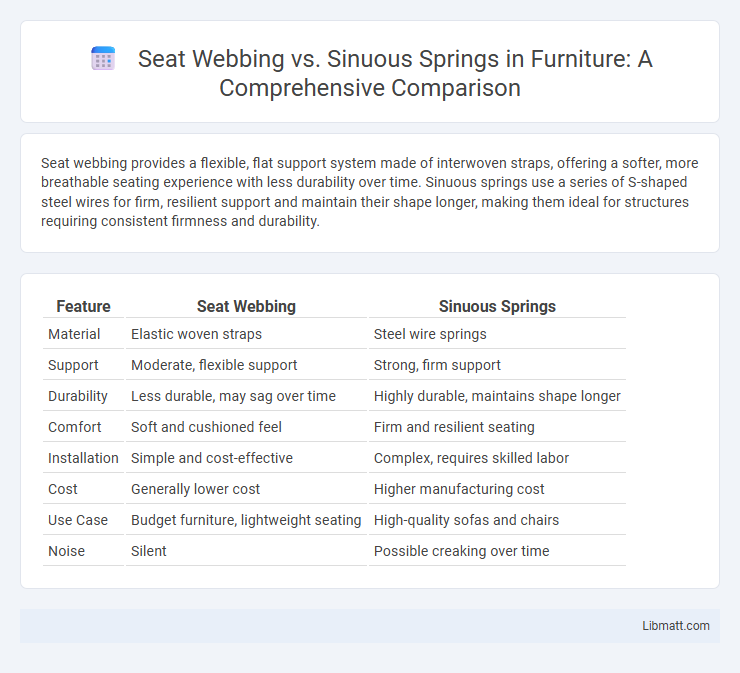Seat webbing provides a flexible, flat support system made of interwoven straps, offering a softer, more breathable seating experience with less durability over time. Sinuous springs use a series of S-shaped steel wires for firm, resilient support and maintain their shape longer, making them ideal for structures requiring consistent firmness and durability.
Table of Comparison
| Feature | Seat Webbing | Sinuous Springs |
|---|---|---|
| Material | Elastic woven straps | Steel wire springs |
| Support | Moderate, flexible support | Strong, firm support |
| Durability | Less durable, may sag over time | Highly durable, maintains shape longer |
| Comfort | Soft and cushioned feel | Firm and resilient seating |
| Installation | Simple and cost-effective | Complex, requires skilled labor |
| Cost | Generally lower cost | Higher manufacturing cost |
| Use Case | Budget furniture, lightweight seating | High-quality sofas and chairs |
| Noise | Silent | Possible creaking over time |
Introduction to Sofa Support Systems
Seat webbing offers a flexible and durable foundation for sofas by using taut strips of material woven across the frame, providing consistent support and comfort. Sinuous springs, made from continuous S-shaped metal coils, deliver responsive cushioning and long-lasting resilience under weight. Both systems are integral to sofa support, balancing comfort, durability, and structural stability in upholstery design.
What is Seat Webbing?
Seat webbing consists of tightly woven strips of jute, rubber, or synthetic materials stretched across a chair or sofa frame to provide foundational support for cushions. Unlike sinuous springs, which use zigzag metal coils to offer bounce and flexibility, seat webbing delivers firm yet flexible support through its interlaced structure. This method is often favored for its durability, noiselessness, and superior weight distribution in upholstery.
What Are Sinuous Springs?
Sinuous springs, also known as zig-zag or zig-zag springs, are metal wires shaped into continuous S-curves that provide support and flexibility in furniture seating. Unlike seat webbing, which uses woven elastic straps for cushioning, sinuous springs offer greater durability and consistent pressure distribution by resisting sagging over time. These springs are commonly found in sofas and chairs, enhancing comfort and structural integrity.
Construction Methods: Webbing vs Sinuous Springs
Seat webbing construction involves tightly stretched strips of material, such as jute or synthetic fibers, woven across the frame to provide foundation support and distribute weight evenly. Sinuous springs consist of continuous S-shaped metal rods anchored to the frame, offering flexible resilience and enhanced durability for the seating surface. Your choice between webbing and sinuous springs impacts the overall comfort, support, and longevity of the furniture.
Comfort and Support Comparison
Seat webbing provides a flexible, evenly distributed support that conforms closely to the body, enhancing comfort by reducing pressure points. Sinuous springs offer firmer, more resilient support with a slight bounce, maintaining seat shape over time and preventing sagging. While webbing excels in softness and initial comfort, sinuous springs deliver superior long-term durability and consistent support.
Durability and Longevity
Seat webbing offers high durability and resistance to sagging due to its tightly woven fabric design, which evenly distributes weight and maintains tension over time. Sinuous springs provide strong, consistent support with their zigzag metal wires, but may lose tension faster and develop squeaks or wear at connection points. Choosing seat webbing can enhance your furniture's longevity by minimizing sagging, while sinuous springs deliver robust support with potential maintenance needs over extended use.
Cost Differences
Seat webbing offers a more budget-friendly option compared to sinuous springs due to its simpler installation and material costs. Sinuous springs, made of heavy-gauge steel coils, tend to increase the overall price of furniture because of their durability and support features. When optimizing your seating investment, understanding these cost differences can help balance comfort and affordability effectively.
Application in Furniture Types
Seat webbing is commonly used in modern sofas, sectionals, and lightweight chairs due to its flexibility and ease of installation, providing supportive yet comfortable seating ideal for less bulky furniture. Sinuous springs are typically found in traditional and upholstered furniture such as armchairs and recliners, offering durable support with a firmer feel suitable for heavy-use seating. Both systems cater to different furniture styles by balancing comfort, cost, and construction complexity.
Pros and Cons Summary
Seat webbing offers excellent flexibility and lightweight support, making it ideal for contemporary furniture designs, but it may sag over time and require frequent replacement. Sinuous springs provide durable, resilient support with better resistance to wear, ensuring long-term comfort but can add extra weight and cost to the seating structure. Choosing between seat webbing and sinuous springs depends on your priorities for comfort, durability, and maintenance.
Which Seating System is Best?
Seat webbing offers firm support and durability by using tightly woven straps that evenly distribute weight, making it ideal for those seeking a stable and long-lasting seating system. Sinuous springs provide greater flexibility and cushioning through continuous S-shaped metal coils, enhancing comfort for prolonged sitting periods. Your choice depends on whether you prioritize firm, consistent support with seat webbing or the plush, resilient comfort delivered by sinuous springs.
Seat webbing vs sinuous springs Infographic

 libmatt.com
libmatt.com